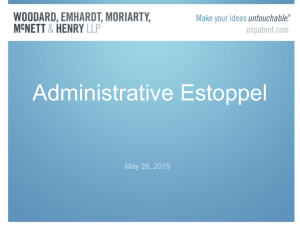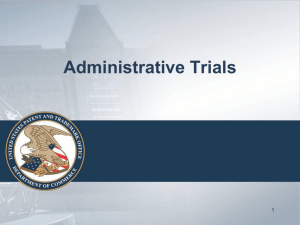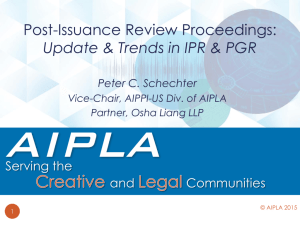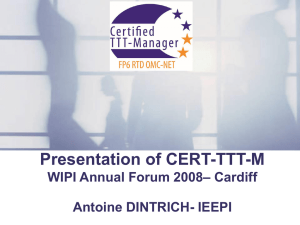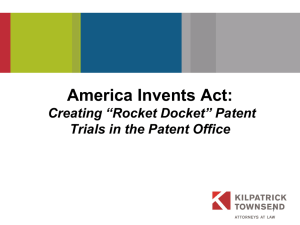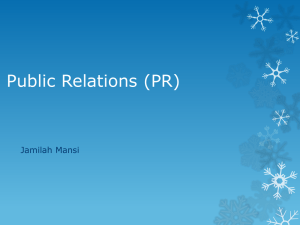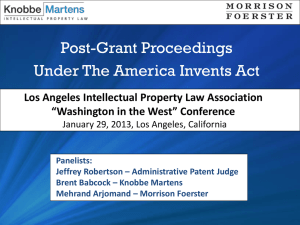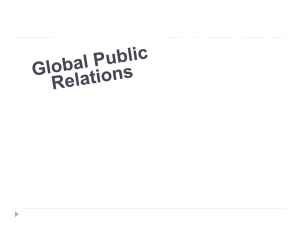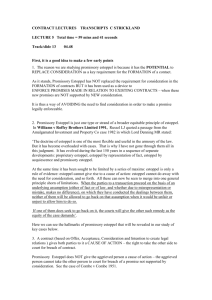Inter Partes
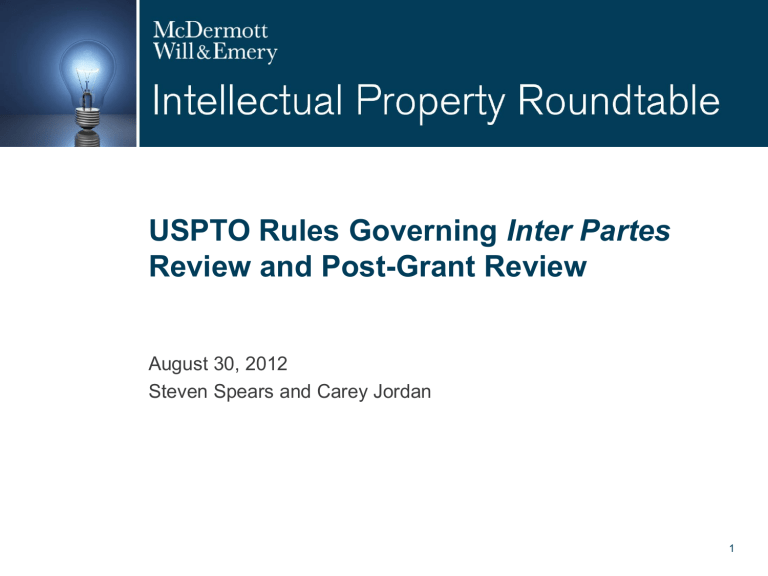
USPTO Rules Governing Inter Partes
Review and Post-Grant Review
August 30, 2012
Steven Spears and Carey Jordan
1
New Post-Grant Proceedings Under AIA
▪ Inter Partes Review (IPR)
▪ Post Grant Review (PRG)
▪ Transitional Program for Covered Business Method Patents
(CBM)
▪ Derivation Procedure (DP)
▪
Supplemental Examination (SE)
2
New Procedures Under AIA
IPR
CBM
PRG
DP
Inter Partes Review (IPR) -- Basics
▪ Available for all patents on or after 9/16/2012
▪ May be filed 9 months after issuance but not (i) after alleging invalidity, or (ii) more than 1 year after being served with infringement complaint
▪ Filed with Patent Trial and Appeal Board
▪ Only for anticipation or obviousness based upon prior art patents or printed publications
▪ Reasonable likelihood that petitioner would prevail on one claim
▪ Limited discovery permitted
▪ Resolution in no more than 12 months after grant of petition
▪ Estoppel – issues “raised or could have raised”
▪ Decisions of PTAB appealed to Federal Circuit
Differences between IPRX and IPR
After 9/16/2012
Patents filed before 11/29/1999
Lawsuit filed before 9/16/2011
Patent owner comment
Discovery
Time to Decision
Oral Hearing Available
Who Decides
IPRX
No
No
Yes
No
No
3 years
No
CRU
IPR
Yes
Yes
No
Yes
Yes
1 year
Yes
PTAB
Differences between EPO Opp. and IPR
When Available
Filing fee
Estoppel
Stay of infringement suit
Discovery
Time to Decision
EPO Opp.
≤ 9 months after grant
Low
No
No
No
2-4 years
IPR
≥9 months after grant
High
Maybe
Maybe
Yes
1 year
Post-Grant Review (PGR) -- Basics
▪ Available for patents with claims having effective filing date after March 16, 2013
▪ Must be filed within 9 months after issuance
▪
Based upon generally any statutory ground of invalidity, or a novel or unsettled legal question important to other patents
▪
More likely than not that at least 1 claim is unpatentable
▪ Same forum, resolution time, and appeals rights as IPR
▪ Contemplated that discovery will be “limited to evidence directly related to factual assertions advanced by either party”
▪ Estoppel – issues “raised or could have raised” -- but many more issues “could be raised”
Covered Business Methods (CBM) -- Basics
▪ Generally applies PGR standards
▪ But available for all subject patents after 9/16/2012 (so long as PRG not available)
▪
Petitioner must be sued or charged with infringement
▪ Patent must cover a business method – generally a method or corresponding apparatus for performing data processing or other operations activities “financial in nature, incidental to a financial activity or complementary to a financial activity.”
▪ Prescribed standard for staying litigation, and interlocutory appeal from any denial of a stay
▪
Estoppel applies only to grounds raised
Timeline – “Umbrella Rules”
Petition
3 months
PO Prelim.
Response
Institution
PO Response
Mot. To Amend
Pet. Reply
Opposition
PO
Reply
Oral
Hearing
≤ 3 month 3 months
3 months
3 months 1 month 2 months ≤ 3 month
PO Discovery Pet. Discovery
PO
Discovery
Observations
Mot. To Exclude
Final
Decision
No More Than One Year
Petition
▪ Publically available, unless filed under seal
▪ $27,200 + $600 for IPR; $35,800 + $800 for PGR
▪ A full statement of the reasons for the relief + evidence
▪ Claim charts and claim construction (broadest reasonable interpretation standard)
▪
60 pages (IPR) or 80 pages (PGR)
▪ Expert affidavits must disclose underlying facts and data
▪
Notice of Real Party-in-interest
▪ Duty of Candor
Patent Owner Preliminary Response
▪ Due 3 months after petition
▪ Not required, and can file waiver to expedite process
▪ No claim amendments
▪ But can disclaim claims
▪ No testimonial evidence unless unauthorized (such as to show estoppel based upon evidence of real party in interest).
Decision on the Petition
▪ Non-appealable (but can seek rehearing)
▪ If review is instituted, Board will specify grounds and claims
▪ Can consolidate, stay, transfer with other matters before the office (PGR, IPR, Reissue)
▪ Sets an initial conference within 1 month to discuss schedule, discovery, and motions
▪ No collateral estoppel arises from denial of a Petition?
▪ De facto estoppel?
Discovery
▪ Routine Discovery: (i) cited exhibits, (ii) cross of declarants, and (iii) “relevant info. that is inconsistent with a position advanced during the proceeding”
▪
Further Mandatory initial disclosures if agreed to or ordered
▪ Additional discovery can be agreed to or sought
▪
Quick, sequenced schedule
▪ E-Discovery
– Not for routine discovery
– Must be raised with the board first
– Follow Federal Circuit Model Order
Depositions
▪ Compelled testimony only during testimony period set by the
Board
▪ 7 hrs direct, 4 hours cross, 2 hours re-direct
▪
If direct, must give list and copies exhibits plus description of scope
▪
Cross limited to scope of direct
▪ Need Board approval for depositions outside the US
▪ Any objections to content must be made at the deposition
▪ Evidence to cure an admissibility objection must be provided during the deposition, unless the parties stipulate otherwise
▪ Cross examination may be ordered to take place before an
APJ
Patent Owner Response/Motion to Amend
▪ Default Due Date – 3 months after review is instituted
▪ Follows discovery on Petition
▪ Response identifies claims addressed in the Board Decision on the Petition that the owner maintains are patentable.
▪ Includes claim construction, affidavits, cross exam, other evidence
▪ Can Move to Amend Claims:
– No authorization needed for first amendment, but must confer with APJ
– Can be proposed as alternative relief
– Cannot broaden claims or add new matter
– “Reasonable” number of substitute claims
– Authorization needed for any later amendment (good cause)
Petitioner’s Reply / Opposition to Amendment
▪ Default Due Date – 3 months after Opposition/Motion to
Amend
▪ Follows discovery on Opposition and any Motion to Amend
▪
15 pages
▪ No new issues or evidence permitted
▪
If want to file supplemental information, must move to so within 1 month of trial institution
▪ If want to submit supplemental information later, motion must show why information could not have been submitted earlier
Patent Owner’s Reply on Amendment
▪ Default Due Date – 1 Month after Petitioner’s Opposition to
Motion to amend
▪ 5 pages
▪
Can only address proposed claim amendments
Observations
▪ If a cross examination occurs after a party has filed its last substantive paper, it may move to file “observations” on that testimony.
▪
A concise, 1 paragraph statement of the relevance of the identified testimony
▪ Opposing party may file a response, but many not file its own observations without prior authorization
Motions to Exclude Evidence
▪ Time for filing set in scheduling order
▪ Must have properly preserved the objection
– If deposition evidence, must object at the deposition
– Evidence to cure the objection must be provided during the deposition, unless parties stipulate otherwise
– If evidence submitted in petition, must serve objections within 10 days of institution
– Otherwise, within 5 days of evidence submission
– Submitter has 10 days to serve supplemental evidence
▪ All evidence not subject to a motion to exclude will be considered admissible
▪ Federal Rules of Evidence apply
Oral Hearing
▪ Must be requested (time to do so set in schedule)
▪ Within 9 months of institution
▪ 3 member panel of the Board
▪ Likely no live testimony
▪ No new evidence or arguments
▪ Do not just rehash briefing
Final Written Decision and Appeals
▪ Within 3 months of oral hearing
▪ Can move for rehearing
▪ Appeals taken to the Federal Circuit
▪ ESTOPPEL
– Only attaches if there is a final decision
– PTO says only “on any ground that the petitioner raised or reasonably could have raised during the trial.” 42.73(d).
– Congress says “on any ground that the petitioner raised or reasonably could have raised during that …review” 35 U.S.C. § § 315(e)(1),
325(e)(1)
– Patent owner cannot pursue patentably indistinct claims or denied specification amendments in another application
Top Ten Reasons To Use IPR or PGR
10. You want to save time and money
9. You have not been threatened with infringement
8. You like the better standards – “preponderance of the evidence” and “broadest reasonable construction”
7.
You want an alternative to arbitration in a license agreement
6.
You do not like the venue where you were sued for infringement
Top Ten Reasons To Use IPR or PGR
5. A jury would never understand your invalidity position
4. You want an invite to an ex parte action
3. You want 2 bites at the apple (Split invalidity claims or invalidity/infringement)
2. Court-style discovery would hurt your position
1. The patent owner has far better witnesses
Owner’s Strategic Issues – IPR and PGR
▪ Short timeline means you must marshal resources quickly
▪ Identify early what discovery is needed
▪ File a preliminary response?
▪ Use duty of candor
▪ Take advantage of “inconsistent position” discovery
▪ Assert patents in venues adverse to stays
▪ Beware of intervening rights – do not make claim amendments or arguments without considering broad impact.
▪ Beware of potential for estoppel

